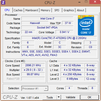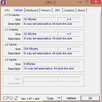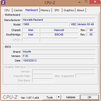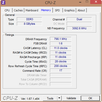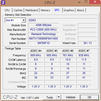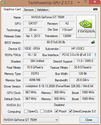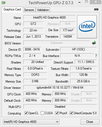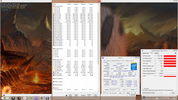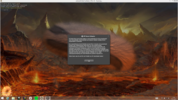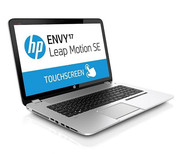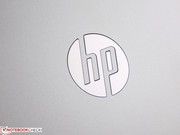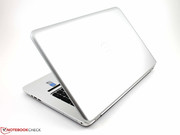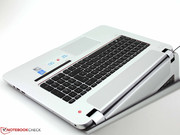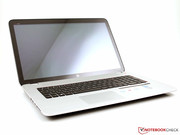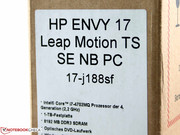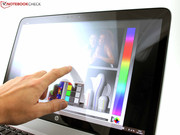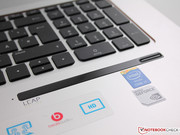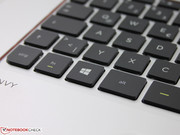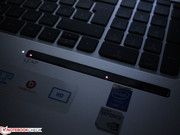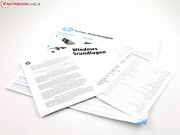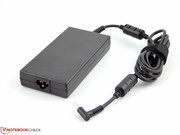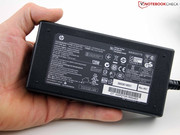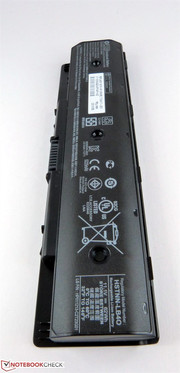Review HP Envy 17-j110eg Leap Motion Notebook

For the original German review, see here.
It has only been a few months since we took a closer look at the HP Envy 17t-j003 (Nvidia GT 740M). The matte display has now made way for a glossy touch panel, and a blackish Leap Motion sensor has been included into the right hand side of the palm rest of the 17-inch laptop. We have already reviewed this gesture control system in a separate article (review Leap Motion gesture control).
Our verdict in August wasn't the most enthusiastic one: Since applications for consumers (games) as well as great Windows support was lacking, we weren't able to utter a recommendation for buying the USB-connected Leap Motion controller. Could this impression have changed in the last three months?
The second novelty concerns the Full HD panel which now comes with touch support. Thirdly, the graphics card has been upgraded from a GT 740M to an upper middle-class GT 750M, although this GPU is more often being used in more affordable Leap-less versions of the Envy 17 as well.
The competition? Most of our multimedia top 10, among them the Asus N750JV-T4110H (i7-4700HQ, GT 750M; 1300 Euros, ~$1786) with a comparable CPU and the same GPU and the (still Ivy Bridge based) Samsung ATIV Book 8 Touch 880Z5E X01 (i7-3635QM, HD 8870M; 1300 Euros, ~$1786) with its AMD GPU.
Because the chassis hasn't changed, this review will skip an extensive evaluation and description of the build quality, ports, speakers and other features (with the exception of the Leap Motion controller). All of these aspects have already been covered in our review of the HP Envy 17t-j003.
Keyboard
There is one thing we have to mention concerning the keyboard, as HP's quality control division has managed to get rid of one issue: The keyboard deck doesn't wobble any more when typing, including the numpad. Just a small area to the left and to the right gives in a little bit (even before the key is truly pressed down), but this is hardly noticeable. Other than that, the keyboard is just as good as it used to be (see the review of the predecessor, yielding a clear pressure point, medium key travel and flat keys), while falling short of an excellent typing experience (more key travel and perfectly sized, conical keys would be needed to deserve this moniker).
The reason for the increase in stability is easily found when the bottom panel is taken off: HP has inserted a massive piece of metal into the second, empty drive bay.
Touch Panel
When compared to the non-touch version, the touch panel of the high-end Envy 17 leads to an edge-to-edge appearance of the new panel, as with almost all touch-enabled laptops. This plastic layer in front of the actual display is a lot tougher, more scratch-proof and comes with better pressure resistance than ordinary laptop panels. The 10-finger touch panel (up to 10 fingers are recognized individually) works well, all input commands are handled with high precision and no noticeable lag.
Leap Motion
The Leap Motion controller is located at the right hand side of the palm rest, being activated via Fn+Space (works even when running on battery). The Leap Visualizer shows immediately what the shift to the right of the infrared sensor means, as the left hand will only be recognized as soon as it starts hovering right above the touchpad. The user thus has to relocate their hands to the right (which is not as annoying as it may sound).
We installed Touchless for Windows from the Airspace Store, although it did not work in one instance. Jack Lumber and a few other free apps can be controlled up to certain degree of precision. The sensor can be calibrated using a reflecting surface - which we did, in hope of better navigation results. Unfortunately, the situation didn't improve.
Other demo apps such as Cyber Science Motion do showcase the possibilities, but we still asked ourselves why this input method is supposed to be superior to the touchscreen or the mouse. The hyperactive cursor just doesn't want to stand still above the button, our little alter ego didn't move as intended and supposedly precise gestures often led to comical results. It definitely wasn't faster than using any other input method - even after two hours of trial and error, we didn't experience any truly captivating moments with this device.
Much more time and ambition has been invested by the author of our article Leap Motion gesture control, which is recommended reading for anyone interested in the Leap Motion. The following video stems from that article as well.
The now glossy 17.3-inch AUO panel (AUO219D) comes with a Full HD resolution of 1920x1080 pixels, yielding a pixel density of 127 ppi. It may not be an IPS display - apparently, few of these are available with 17.3-inches, as the Envy's competitors such as the Asus N750JV (TN) or the ATIV Book 8 Touch 880Z5E (MHVA) make use of displays with worse viewing angles as well, but HP does at least use one of the best TN panels available.
The brightness of 260 cd/m² is decent, but not great. Some competitors such as the N750JV (331 cd/m²) offer more. Similar observations hold true for the contrast ratio of 753:1, which is a bit better than that of the N750JV, but not as good as that of the ATIV Book 8 Touch (1017:1).
| |||||||||||||||||||||||||
Brightness Distribution: 85 %
Center on Battery: 271 cd/m²
Contrast: 753:1 (Black: 0.36 cd/m²)
ΔE ColorChecker Calman: 9.81 | ∀{0.5-29.43 Ø4.78}
ΔE Greyscale Calman: 10.65 | ∀{0.09-98 Ø5}
64.1% AdobeRGB 1998 (Argyll 3D)
87.7% sRGB (Argyll 3D)
65.6% Display P3 (Argyll 3D)
Gamma: 2.34
CCT: 12857 K
Color space coverage is a crucial characteristic when it comes to professional programs such as Adobe Lightroom, Quark XPress or InDesign - a display should come very close to covering the AdobeRGB or at least the sRGB color space. Apart from a few high-end workstations, barely any laptop has ever come close to these goals, and the HP Envy 17 and its competitors are no exception to this rule.
We measured the display properties with a photo spectrometer before calibrating. Large pre-calibration DeltaE deviations could be observed, with ColorChecker measuring a DeltaE value of almost 10. Both the N750JV and the ATIV Book 8 Touch are better in this regard, reaching a DeltaE value of approximately 3, coming close enough to the actual colors for the eye to be incapable of noticing the difference. Similar results hold true during our grayscale examinations - once more, the Asus and Samsung laptops fare a lot better with DeltaE values of 2 to 3.
Those who do a lot of work outdoors will miss the matte display of the Envy 17-j110eg's siblings. Despite its decent brightness levels, the strong reflections are difficult to overlook. In the shade as well as on cloudy days, users should be fine, working with a well-lit display.
In terms of viewing angle stability, both our Envy 17 test device and the Asus N750 don't stand a chance against the ATIV Book 8 with its IPS-like (in terms of vertical viewing angles) MVA panel. Although it takes a very narrow horizontal angle before contrast shifts can be noted (140 degrees overall), color inversions occur quickly when vertical displacements are unavoidable.
The Core i7-4700MQ (2.4 GHz) as used in the Envy sibling HP Envy 17t-j003 has been quite the vulgar processor, being a true quad-core with a TDP of 47 watts instead of the much more "sexy" 17 or 15 watts which Intel has worked so hard to achieve. Things have changed in the case of the i7-4702MQ (2.2 GHz), with the TDP being decreased to 37 watts, being accompanied by a 200 MHz decrease in terms of clock speed. With Turbo Boost, up to 3.2 GHz can be achieved (4700MQ: 3.4 GHz).
The Intel HD Graphics 4600 of the CPU gets augmented by an upper middle-class GeForce GT 750M which might be something of a game changer for gamers. We will perform a detailed comparison with the GT 740M of the first Envy 17 sibling below.
Since it is a multimedia laptop first and foremost, the Envy 17 requires a lot of storage space, and the 1 TB Toshiba HDD delivers. Unfortunately, HP neither offers an SSD-based variant nor is it easy to use the second drive bay to insert another hard drive, as the right (flat) SATA cable as well as an appropriate drive chassis would be needed.
Processor
So what about the CPU downgrade? According to Cinebench R11.5 (which we use to test both the pure CPU performance as well as to check the usage pattern of the Turbo range), the new CPU falls behind by 7 to 11% (single- and multithreading respectively) when compared to the 4700MQ as used in the HP Envy 17t-j000, not too shabby given the much lower TDP. It takes a low voltage i7 system such as the premium 17-inch laptop Dell Inspiron 7737 or the Acer Aspire V7-582PG to deliver noticeably lower performance levels. Both ship with a dual-core Core i7 CPU with a TDP of 15 watts and 60 to 70% less performance, making the choice an easy one for those mostly interested in a fast CPU. The Envy's two main competitors, the ATIV Book 8 and the Asus N750 offer more or less exactly the same performance levels.
The Envy 17 remains quite the performer even when looking at its Turbo Boost capabilities, reaching up to 3.1 and 2.9 GHz during single- and multithreading tasks respectively. While running on battery, the same high frequencies are being used (this holds true for all Cinebench R11.5 tests including OpenGL ident).
System Performance
Still, exceptional application performance levels are not achieved, as confirmed with PCMark. The Envy 17 is pretty much as fast as all other HDD-based 17-inch laptops; even the Inspiron 7737 with its much weaker CPU falls behind by just 15%. The Acer Aspire V7-582PG takes the lead by + 34%, but mostly due to its SSD cache, as seen by a glance at its storage sub-score (+ 154%).
| PCMark 7 Score | 3185 points | |
| PCMark 8 Home Score Accelerated | 3447 points | |
| PCMark 8 Creative Score Accelerated | 4134 points | |
| PCMark 8 Work Score Accelerated | 4479 points | |
Help | ||
Storage Devices
The 1 TB HDD (Toshiba MQ01ABD100) is on par with most other comparable HDDs with 5400 rpm, being the same hard drive as the one used in the HP Envy 17t-j000. The increased 4K values (of 16%) are within the error margins of this test; an SSD should be much faster still, routinely yielding 20 to 30 MB/s instead of just 0.35 MB/s.
Graphics Card
This is not the first time that we have reviewed the GT 750M GPU. Its own DDR3 memory (4 GB) is connected via a fast 128-bit interface, with the GPU core speed reaching up to 1085 MHz when the turbo mode is active. GDDR5 might enable the GPU to yield even better performance levels, as shown recently by the Dell XPS 15, which achieved almost 30% more points during the GPU test of 3DMark (2013) Firestrike. The direct competitor, the Samsung ATIV Book 8 Touch 880Z5E, fares even better, with an increase of 46 to 48% thanks to its HD 8870M. The MSI GE70 with its high-end GTX 765M is even faster, reaching +55%.
| 3DMark 06 Standard Score | 13797 points | |
| 3DMark Cloud Gate Standard Score | 8632 points | |
| 3DMark Fire Strike Score | 1527 points | |
Help | ||
Gaming Performance
The gaming performance is good enough to allow for high details being chosen in most games, at least when the resolution is decreased from Full HD to HD (1366x768). Still, the GT 740M of the Envy's sibling had a lot of trouble with even these reduced settings. However, the XPS 15 (i7-4702HQ) is once again much faster thanks to its advantageous GDDR5 memory. Talking about AMD GPUs, the Radeon HD 8870M remains the better choice for demanding games when compared to the GT 750M with DDR3. The GT 740M cannot compete with these GPUs.
| HP Envy 17-j110eg GeForce GT 750M, 4702MQ, Toshiba MQ01ABD100 | Asus N750JV-T4110H GeForce GT 750M, 4700HQ, Seagate Momentus ST750LM022 HN-M750MB | HP Envy 17t-j000 GeForce GT 740M, 4700MQ, Toshiba MQ01ABD100 | Samsung ATIV Book 8 Touch 880Z5E X01 Radeon HD 8870M, 3635QM, Toshiba MQ01ABD100 | Dell XPS 15 (Late 2013) GeForce GT 750M, 4702HQ, Samsung SSD SM841 512GB | |
|---|---|---|---|---|---|
| The Elder Scrolls V: Skyrim | |||||
| 1366x768 High Preset AA:8x AF:8x (fps) | 39.9 | 31.3 -22% | 25.4 -36% | 54.4 36% | |
| Tomb Raider | |||||
| 1366x768 High Preset AA:FX AF:8x (fps) | 38.1 | 40.2 6% | 23.8 -38% | 58.4 53% | 58.2 53% |
| BioShock Infinite | |||||
| 1366x768 High Preset (fps) | 44.8 | 31 -31% | 61.1 36% | ||
| Total Average (Program / Settings) | -8% /
-8% | -35% /
-35% | 45% /
45% | 45% /
45% |
| low | med. | high | ultra | |
|---|---|---|---|---|
| The Elder Scrolls V: Skyrim (2011) | 39.9 | 21.8 | ||
| Medal of Honor: Warfighter (2012) | 39.2 | 15.3 | ||
| Dead Space 3 (2013) | 64 | 38.6 | ||
| Tomb Raider (2013) | 38.1 | 17.8 | ||
| BioShock Infinite (2013) | 44.8 | 16.3 |
Noise Emissions
The HP Envy 17 is quite the noisy laptop, even while idle, with an obtrusively active fan which never stops spinning. Almost all competitors are a bit more silent, with the Samsung ATIV Book 8 Touch 880Z5E being almost inaudible at 30 dB(A). Samsung's laptop remains the least noisy one even under full load while the Asus N750 is much louder. Still, our test device remains the king in terms of loudness. At least, it produces a constant background noise without any annoyingly high frequencies, rendering its 38 dB(A) under medium loads more or less acceptable.
Noise level
| Idle |
| 32.8 / 34.4 / 34.4 dB(A) |
| HDD |
| 32.8 dB(A) |
| DVD |
| 36.2 / dB(A) |
| Load |
| 38.3 / 46.2 dB(A) |
 | ||
30 dB silent 40 dB(A) audible 50 dB(A) loud |
||
min: | ||
Temperature
High noise emissions equal low heat emissions? This once more holds true in case of the Envy 17, with the constantly spinning fan allowing it to run cooler than the Asus N750 or the Samsung ATIV Book 8 while idle (24 °C). Under constant full load (stress test), the HP does remain noticeably cooler (on average) than the ATIV Book 8, with its surface temperature of around 45 °C being on par with the N750.
The CPU does get up to 95 °C hot during the stress test, leading to a slight reduction in CPU clock speed to a range between 2.4 and 2.7 GHz. The GT 750M remains unimpressed, staying at its maximum Turbo clock speed of 1162 MHz at all times. As soon as the GPU isn't taxed any more, leaving only Prime 95 challenging the CPU, the processor temperature falls to 83 °C, leading to a stabilized clock speed of 2.6 GHz. While this is a bit less than during the Cinebench R11.5 multithreading benchmark (2.9 GHz) it is by no means throttling as the base clock speed of 2.2 GHz is never undershot even under full load.
(-) The maximum temperature on the upper side is 45.2 °C / 113 F, compared to the average of 36.9 °C / 98 F, ranging from 21.1 to 71 °C for the class Multimedia.
(±) The bottom heats up to a maximum of 41.9 °C / 107 F, compared to the average of 39.2 °C / 103 F
(+) In idle usage, the average temperature for the upper side is 22.9 °C / 73 F, compared to the device average of 31.3 °C / 88 F.
(+) The palmrests and touchpad are reaching skin temperature as a maximum (34 °C / 93.2 F) and are therefore not hot.
(-) The average temperature of the palmrest area of similar devices was 28.7 °C / 83.7 F (-5.3 °C / -9.5 F).
Power Consumption
The Envy 17 is a rather efficient laptop: 7 to 12 watts while idle (minimum brightness) are better than both its sibling (HP Envy 17t-j000, 8 to 14 watts) as well as the main competitors (Asus N750, 9 to 18 watts; Samsung ATIV Book 8, 10 to 16 watts).
During constant full load (stress test with Prime95 and Furmark), the power adapter of the HP (officially capable of providing up to 120 watts) seems to be in trouble, as a popup notification suggesting the purchase of a more powerful smart power adapter shows - even though such an adapter is nowhere to be found on HP's accessories website!
In reality though, the 99 watts (constant power consumption during the stress test) aren't even that much given the powerful CPU and GPU with their still rather high TDP. It should be mentioned though that most other 17-inch laptops consume just around 80 watts under full load.
During normal usage, the entire system with its 37 watts CPU is 25% more power-efficient than the Asus N750JV, remaining on par with the Samsung ATIV Book 8.
| Off / Standby | |
| Idle | |
| Load |
|
Key:
min: | |
Battery Life
The most exciting question here is whether the CPU downgrade leads to an improved battery life. Indeed, while idle, the runtimes are increased by 30% when compared to the HP Envy 17t with its Core i7-4700MQ. However, our more life-like Wi-Fi test reveals an improvement of just 8%, and the resulting 214 minutes are far from what we might want to call a decent result. Even non-low-voltage competitors such as the Samsung ATIV Book 8 Touch 880Z5E (+80%) or the Asus N750JV-T4110H (+28%) offer much better battery life, albeit with higher-capacity batteries.
Verdict
HP's multimedia powerhouse HP Envy 17 may have changed its face, but its character stays the same. The CPU downgrade from 47 to 37 watts is barely an issue in terms of performance. Quite the opposite, as the GT 750M replacing the GT 740M actually yields better gaming performance (one disadvantage: GDDR3). With a simple trick, HP has managed to create a much sturdier keyboard deck, increasing its ratings in this regard. The display is still of the TN variant, but now a glossy touch panel has been used instead of the matte non-touch variant.
Leap Motion, as it presents itself today, is neither a clear winner nor a disappointment. The extra cost of 60 Euros (~$82) is not too much to swallow given the much higher base price point of almost 1200 Euros (~$1648) for the HP Envy 17, especially since the Leap Motion edition is the only one which includes a touch panel.
The Envy 17 is best suited for tech enthusiasts who like to try out new technologies (Leap Motion, touch panel) while also being fond of demanding computer games. Those who prefer a matte display and a premium aluminum chassis might want to have a closer look at the Asus N750JV-T4110H which not only offers the same gaming performance but also an external subwoofer. If battery life and perfect build quality are the most crucial factors, Samsung's ATIV Book 8 Touch 880Z5E X01 might be a sensible choice. The latter device also comes with the most vivid colors (albeit in a glossy panel) which is actually useable for professional usage scenarios (low DeltaE).




















